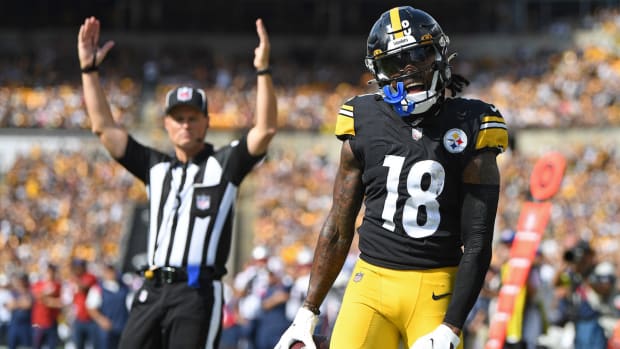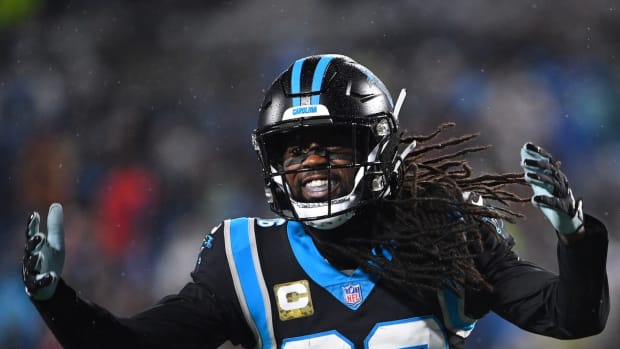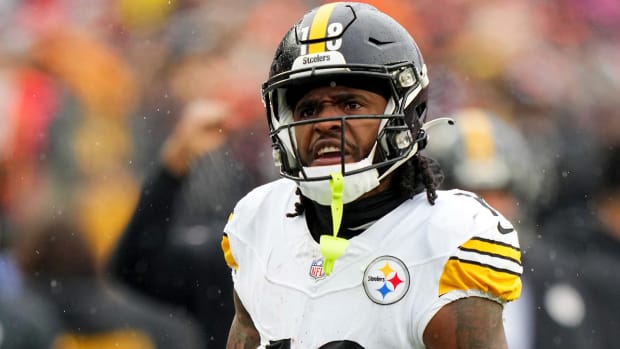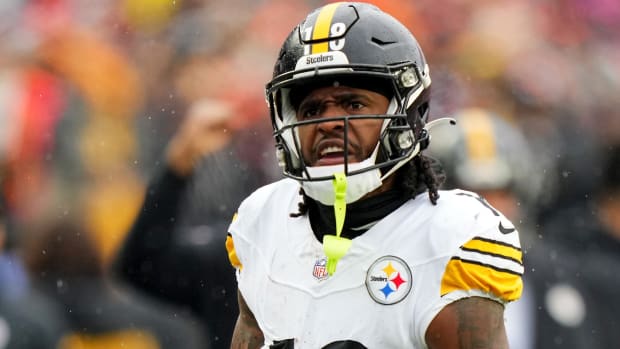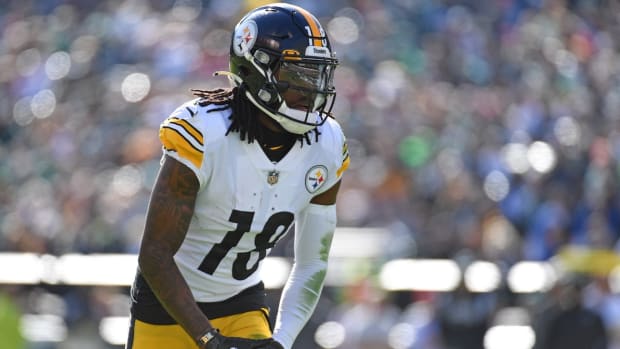Film Room: Benny Snell's Rookie Campaign Proved Impressive
When you think of Benny Snell, a few things come to mind.
If you're a Penn State fan, you think of Snell's dominating 144 yard/2 touchdown performance in the Citrus Bowl prior to his entrance in the 2019 NFL Draft, a performance that saw Snell grab Kentucky's career rushing record.
If you're just here for fashion or memes, Snell's mouthpiece now has a whole generation of young football players wishing to have spinners on their grill.
As for the Pittsburgh Steelers, Snell can be looked at as bruiser on the football field. His power and motor at the running back position was enticing enough to put Snell in black and gold despite the presence of James Conner.
Snell's rookie campaign doesn't offer much if you're simply box score scouting. 116 attempts across 13 games for 2 touchdowns doesn't exactly scream rookie of the year honors. With Conner now healthy again and Anthony McFarland now in the mix, the Steelers backfield is murky to say the least.
However, when it comes to Snell's tape last season, one can come to the conclusion that 2019 proved Snell is capable of significantly contributing in the future.
To evaluate Snell, I picked five different categories to assess: Pass catching, ball security, inside the tackle running, outside runs and the ambiguous "other" category. All videos were used via NFL Game Pass, and show All-22 angles on the first clip, with a box view in the second clip.
An evaluation of Benny Snell's rookie season in Pittsburgh:
Ball Security
With one fumble through 119 touches, Snell at the least can't be diagnosed with butter-fingers. Even his lone fumble of the season in Arizona was due to a shoulder popping the football in the air.
Following the fumble, Snell attacked crowded areas with both arms surrounding the ball the rest of the way. Fumbling the football is bound to happen, but good running backs don't make the same mistake twice. I also noticed that Snell does a good job of switching the ball to his outside arm when near the sideline, a small but important technique implemented by running back coaches.
Snell's tape gave no reason to believe he'll consistently cough the football up moving forward.
Pass Catching
Snell wasn't exactly a go-to target in the passing game during his time at Kentucky, and that trend continued into 2019. Snell caught a whopping three of four targets last season, with the lone missed reception thrown over his head by Devlin Hodges on a broken screen play.
The Steelers made their intentions with Snell very clear: He's there to run the football. However, that's not to say Snell can't snatch the football when called upon.
He's no Le'Veon Bell when it comes to the passing game, and if there's any criticism when it comes to his ability to catch the ball, Snell likes to trap the ball to his body as opposed to using his hands.
However, that is one small complaint in a territory of Snell's arsenal that has yet to be truly explored. With McFarland's presence in the Steelers backfield, it's unlikely we see an uptick in targets for Snell in 2020. However, it is nice to know that Snell will reel in the catch if called upon.
Inside Running
If there's one characteristic to describe Snell's running style, it's his north-south (runs straight and picks yards up directly) running ability. Snell is absolutely at his best when he's running right in the soul of the defense.
When Snell touches a football, he finds a hole and bursts through. This was on display on his very first NFL carry.
Snell has quick feet for a back of his stature, and part of what makes him successful between the tackles is his quick footwork. In the video below, watch Snell plant his feet and readjust to the opening of the hole. He explodes through and finds daylight.
Snell isn't Barry Sanders when it comes to making defenders miss. You won't see LeSean McCoy comparisons any time soon. However for a "power" back, Snell does a great job of making defenders miss not with ankle-breaking moves, but with a simple step outside of the defender's reach.
In what is perhaps his best feature, Snell's ability to keep his legs churning and create extra yards is admirable on film. Snell continually churned out extra yards thanks to his efforts, and this was on display vs Cleveland.
A solid combination of consistent legs and balance also nearly saw him score in Baltimore.
Averaging nearly four yards per carry his rookie season, Snell's ability to run between the tackles was seen on a consistent basis in 2019. Often times Snell was met at the line of scrimmage or in the backfield by defensive players, likely due to a mixture of sporadic offensive line play and stacked boxes with a defense taking their chances against the likes of Mason Rudolph and Devlin Hodges.
Snell's power and ability to hit the hole straight ahead is somewhat rare in backs these days, so seeing a running back put his shoulders down and run north and south is reminiscent of the older days of football. Snell's ability to maintain movement in his legs ensures he fights for every yard possible, and perhaps that's my most impressive takeaway from his rookie season.
Bouncing Outside and Running in Space
If you didn't get the message by now, Snell does his best work between the tackles. That's not to say Snell isn't capable of bouncing plays to the outside or isn't capable of making defenders miss in space. Through his first few games, Snell mainly stayed between the tackles and refused to stretch the play to the boundary. Knowing he would cut inside if running on stretch plays or zone reads, Snell at times put himself in positions where he would run into his own blockers rather than running to the outside.
In example on the play below, Snell is running to the right before recognizing the gaping running lane. However, Snell's positioning forced him to take a wide step and ultimately crash into the receiver blocking. Had Snell smoothly cut inside or waited a fraction of a second longer to bounce outside, he likely hits a larger gain. (Yeah, it's easy saying this from the couch, why do you ask?)
Snell's no track-star by any means, meaning he typically won't beat a defender to the edge or in a foot race. Nobody in Pittsburgh expects him to replicate what LaDainian Tomlinson was able to do, but his rookie season reminds me much of what we saw from Le'Veon Bell in terms of not being fully adjusted to the speed of the game. As we all know, Le'Veon came back and improved vastly in aspects such as speed in the following seasons, and that's the hope for Snell as well.
Even with the lack of speed, Snell is able to gain an extra ten yards after initial contact.
Yet in what Snell lacks in speed, he makes up for with a quick initial step, allowing him plenty of room to operate. In the video below, Snell receives the ball and immediately shifts left where he's met by a defender. Snell is able to quickly avoid the defender with a simple twist of the shoulder and turn a one yard loss into a large gain.
That slight side-step was on display once Snell found his footing in his rookie season, especially in Baltimore where Snell was able to avoid a defender with a slight move and finish the run to the sideline for a positive gain.
As mentioned previously, Snell would often opt to cut inside rather than following his blockers to the outside early in the season. As the season progressed, however, Snell appeared to be more trusting of the flow of the play rather than simply running straight ahead with full steam. Against the New York Jets in the video below, Snell had an opportunity to cut inside with two pulling offensive linemen in front of him. Rather, Snell allowed his linemen to seal the edge, giving Snell nothing but green grass to work with.
Snell offers a lot when running outside of the hashmarks. He's very capable of making players miss in the open field despite not being billed as a juking maestro. Snell possesses the ability to slightly move his body out of reach and burst to the next level. It took Snell a bit of time and learning to trust himself outside of the tackles, yet he proved himself very capable of running to the boundary when needed. On a handful of plays, Snell sometimes will run himself into blockers or make wrong reads, but what running back is perfect on every play?
The "Other" Category
This section is simply for the other small things I noticed while watching Snell. Perhaps miscellaneous would be better suited for the category.
I was interested to see Snell in pass protection, as protecting the quarterback (in my humble opinion) is an underrated tool for a running back to possess. Pittsburgh ran a lot of play-action with Snell, where Snell would fake the handoff before eventually chipping a defender before rolling out as a checkdown option. Aside from one play where Snell blocked for Diontae Johnson on a sweep play, I was only able to find one play where Snell was tested in pass protection.
He passed. Snell steps in wonderfully as the defender in the A gap is nearly left unblocked. Snell (with a little assistance from DeCastro) handles his assignment with ease.
Snell's vision isn't something to knock against him, but at times it was shaky. I alluded to Snell running into blockers and picking wrong gaps, but those plays were far and few between. On this play against the Ravens, Snell displays the ability to spot an opening, plant his feet, and weave around his blockers. This type of run wouldn't (and didn't) happen at the beginning of the season, giving some proof that Snell's play was trending in the right direction.
Takeaways From Snell's Film
Admittedly so, prior to sitting down and watching every snap Snell took in 2019... I wasn't convinced he was a viable three down back to move forward with. However, I can now say that I was wrong.
Snell, for the better part of his season, fell victim to stacked boxes and inconsistent help from his offensive line. This led to many plays where Snell simply had to take what was given to him.
There's a lot to like about Snell. He's tough. He's physical. He seems to get better the more he is fed. Snell earns yards by continually keeping his legs moving, and his ability to stick to running straight and simple is a welcome sight in a league where many backs choose to move horizontally and lose potential yards because of it. Yet he's not just limited to a short yardage role, as he displayed many times the ability to make defenders miss in the open field.
Snell was undoubtedly limited last season, and if James Conner can stay healthy in 2020, that trend should continue. However, Snell impressed enough to earn a larger role. With Anthony McFarland and potentially Jaylen Samuels in the picture, Snell remains unlikely to emerge as a pass-catching back in this offense.
Snell's rookie campaign wasn't without flaw, though. At times it felt like he already had a predetermined destination despite the defense and blocking saying otherwise. His catches were primarily used by trapping the football against the body, which doesn't bode well should a defender be in the area. Snell lacks the true speed to waive defenders goodbye when he hits the second level, and still is prone to make incorrect reads that result in a loss.
With all the above stated: Snell played considerably well for a rookie in a dysfunctional situation. Snell's skill-set provides a solid base for him to build on, and if he's able to progress in year two, 2020 should see Snell evolve into a reliable player the Steelers can count on moving forward.
Donnie Druin is a Staff Writer with AllSteelers. Follow Donnie on Twitter @DonnieDruin, and AllSteelers @si_steelers.

